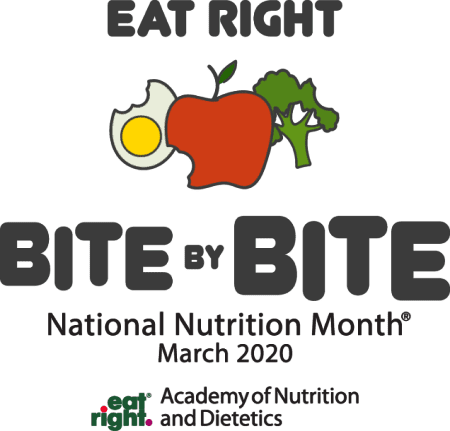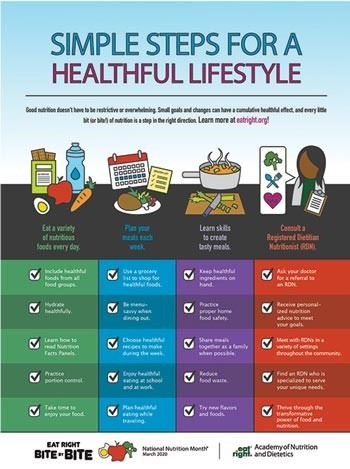Eat Right, Bite by Bite for National Nutrition Month
- Category: News
- Posted On:
- Written By: Reema Kanda, RDN, Registered Dietitian Nutritionist at HOI

March is National Nutrition Month® (NNM) and it is an annual nutrition education campaign created by the Academy of Nutrition and Dietetics. The campaign invites the community to focus on the importance of making informed food choices and developing sound eating and physical activity habits. This year’s theme is Eat Right, Bite by Bite, and supports the philosophy that every bite of nutrition can be a step in the right direction towards better health. Small changes can add up and help get us started on improving our health.
Come join the Registered Dietitian Nutritionist (RDN) community in celebrating every little “bite” of nutrition. The below recommendations can help kick off or continue your healthful lifestyle. Remember that good nutrition does not have to be so restrictive and overwhelming.
- Eat a variety of nutritious foods every day.
- Include healthful foods from all food groups. Your body needs nutrients for your health to thrive. Include whole grains, protein foods, low fat or fat-free dairy or calcium-fortified dairy alternatives, and a variety of fruits and vegetables.
- Quench your thirst by hydrating with water instead of beverages with added sugars. Water is essential for the body, especially since water helps your body absorb nutrients and cushions your joints, in addition to many other benefits.
- Learn how to read the Nutrition Facts Label on foods. Changes to the labels are in full swing. The label has been updated to include information on nutrients you should get more of, such as Vitamin D, Calcium, Iron, Potassium, and Dietary Fiber. To learn more about all the changes and a guide on how to read the label, visit the Food and Drug Administration (FDA) website https://www.fda.gov/food/nutrition-education-resources-materials/new-and-improved-nutrition-facts-label
- Practice portion control will allow you to have a little bite of everything that you crave while meeting your personalized daily goals. When deciding on what to prepare and eat, follow the MyPlate eating pattern. Focus on whole fruits, add variety to your vegetables, make half of your grains whole grains, vary your protein routine, and move to low fat or fat-free dairy, such as yogurt. If you wish to strictly follow a plant-based diet, you can still use the MyPlate eating pattern. Remember to also focus on less sodium, saturated fats, and added sugars. For more information and help, visit the website https://www.choosemyplate.gov/
- Try to find time to enjoy your food by turning off the TV, phones, and other electronic devices so you can enjoy the flavors and textures of the meals and snacks you’re eating.
- Plan your meals each week.
- Use a grocery list to shop for healthful foods. Look into the refrigerator, freezer, and pantry for foods that need to be used up first and make a list of items you still need. Sticking to the list will not only help you save money and avoid food waste but also help you avoid picking up junk food.
- Be mindful of the menu when dining out. After a busy week or a fun way to mark a celebration, dining out can be a treat but can also be challenging in deciding what to order that will meet your nutrition goals. Many restaurants will have calorie information, but others may also identify menu items as being low in salt and or low carb. If nutrition information is not available, avoid foods that are fried or served in sauces. You may want to avoid certain entrées and sides that use the terms: crunchy, crispy, battered, breaded, creamy cheese, alfredo. Go for entrée and sides that use terms such as baked, grilled, roasted, steamed, al Fresco, and Marinara.
- Choose healthful recipes to prepare during the week. The first step is to pick recipes for the kind of meals you need, for example, meals that can be made in less than 30 minutes or vegetarian. Meal planning doesn’t have to be cooking something new every night of the week. Keep the MyPlate eating pattern in mind when deciding. Cook things you really want to eat. When you that, you're less likely to order pizza or stop at a fast-food restaurant.
- Enjoy healthful eating at school and work. Pack your lunch and bring healthy snacks, so you do not have to hunt down the not so healthy office food or vending machines snacks. If you tend to lose all willpower when faced with office celebrations, be sure to eat a healthy lunch like a chopped salad to prevent carb overload.
- Plan healthful eating while traveling. Scope out restaurants with healthy food you will want to eat ahead of time. Also, bring healthy snacks like dried nuts and protein bars. If you like to travel light, you can buy snacks at the local supermarket soon as you arrive at your destination. One way to commit to eating healthy while traveling is to be sure to have veggies with every meal, even when you're ordering out while traveling.
- Learn skills to create tasty meals.
- Keep healthful ingredients on hand. A well-stocked pantry, refrigerator, and freezer is the way to stay on track for healthy eating. Some suggestions are eggs, avocado oil spray, blueberries, limes and lemons, nut butter, oats, olive oil, canned tuna, just to name a few.
- Practice proper home food safety. Four simple steps, according to the Centers for Disease Control (CDC) and Prevention are:
- Clean by washing your hands and surfaces often.
- Separate foods to prevent cross-contamination
- Cook food to the right temperature
- Chill food by refrigerating promptly
For more information visit the CDC website: https://www.cdc.gov/foodsafety/keep-food-safe.html
- Share meals as a family when possible. Even in a rush, families can still work together for speedy meal preparation, such as adults can be in charge of the entrée, and older kids can prepare a salad, and little ones can help set the table.
- Reduce food waste. Be a smart shopper by avoiding purchasing foods that will expire soon. Reducing food waste is possible with some planning and safe storage habits.
- Try new flavors and foods. It will open a world to many options. The more nutritional variety that you will get from your diet can improve nutrition.
- Consult a Registered Dietitian Nutritionist (RDN).
- RDNs want to help you thrive through the transformative power of food and nutrition. I encourage you to celebrate National Nutrition Month® by keeping it simple and trying new flavors. Eating right doesn’t have to be complicated.
- Ask your doctor for a referral to an RDN if you need assistance with reaching your health goals.
- RDNs can provide personalized nutrition advice to reach your goals.
- Meet RDNs throughout the community. Seek out the supermarket Dietitians at your local markets who can help you understand nutrition labels and can provide in-store education.
- If you have a medical condition, find an RDN who is specialized to serve your unique needs.
Happy National Nutrition Month®! For more resources, please visit the following link: https://www.eatright.org/food/resources/national-nutrition-month/toolkit
Images courtesy of Academy of Nutrition and Dietetics




